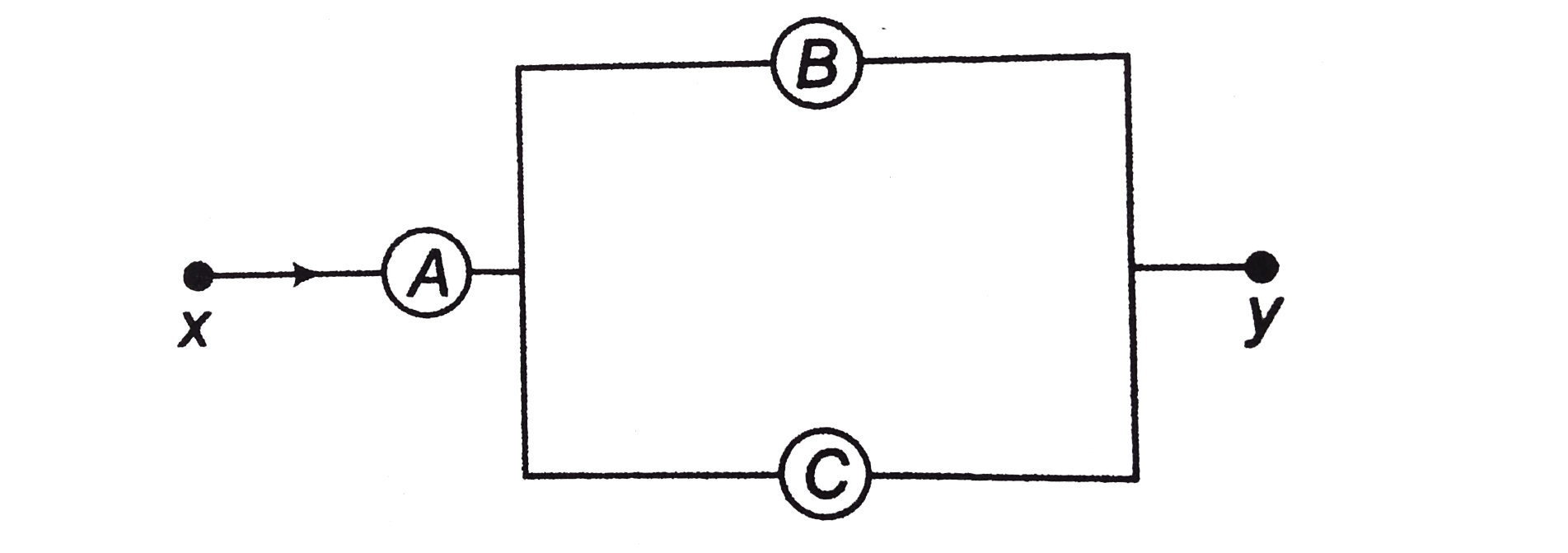Three voltmeters A, B and C having resistances R, 1.5 R and 3 R respectively are used in a circuit as shown. When a potential difference is applied between X and Y, the readings of the voltmeters are V1,V2andV3respectively. Then :

V1=V2=V3
V1<V2=V3
V1>V2>V3
V1>V2=V3
The correct Answer is:A

I1=(1.5R4.5R)I=l3
l2=(3R4.5R)×l=2I3
V1=IR,V2=V3=I.5R×23l=IR
Hence, V1=V2=V3
Similar Questions
Three voltmeters all having different resistance, are joined as shown. When some potential difference is applied acros A and B, their readings are V1,V2 and V3. Then

View SolutionThree voltmeters A,B and C having resistances R, 1.5 R and 3R respectively are used in a circuit as shown
 . When a P.D. is applied between X and Y, the reading of the voltmeters are V1,V2 and V3 respectively. Then....
. When a P.D. is applied between X and Y, the reading of the voltmeters are V1,V2 and V3 respectively. Then....
View SolutionA,B and C are voltmeters of resistances R,1.5R and 3R respectively. When some potential difference is applied between x and y the voltmeter readings are VA,VBandVC, then

View SolutionThree voltmeters A, B and C having resistances R, 1.5 R and 3 R respectively are used in a circuit as shown. When a potential difference is applied between X and Y, the readings of the voltmeters are V_1, V_2 and V_3 respectively. Then :
View SolutionThree voltmeters A, B and C having resistances R, 1.5 R and 3 R respectively are used in a circuit as shown. When a potential difference is applied between X and Y, the readings of the voltmeters are V1,V2andV3respectively. Then :

View Solutionयहाँ आरेख में दिखाये तीन वोल्टमीटरों A, B तथा C के प्रतिरोध क्रमश: R,1.5R तथा 3R हैं। यदि x तथा Y के बीच कुछ विभवान्तर आरोपित करने से, इन वोल्टमीटरों के पठन (रीडिंग) क्रमशः VA,VF तथा VC हैं तो

View SolutionA, B and C are voltmeters of resistance R, 1.5R and 3R respectively as shown. When some potential difference is applied between X and Y, the voltmeter readings are V_(A), V_(B) and V_(C ) respectively. Then
View Solutionदिये गये परिपथ में वोल्टमीट V1 और V2 दोनो के पाठ्यांक 300V हैं, तो वोल्टमीटर V3 और एमीटर A के पाठ्यांक क्रमशः होंगे

View Solution

